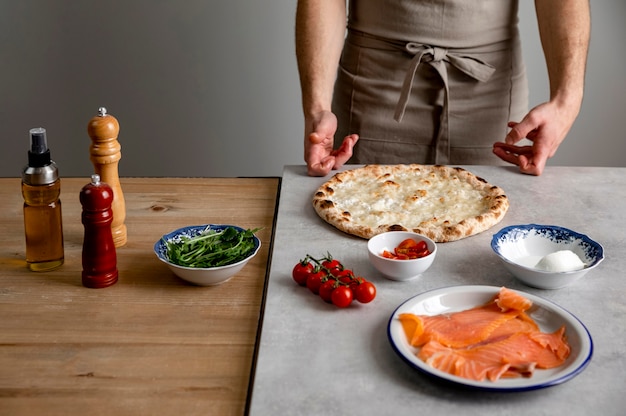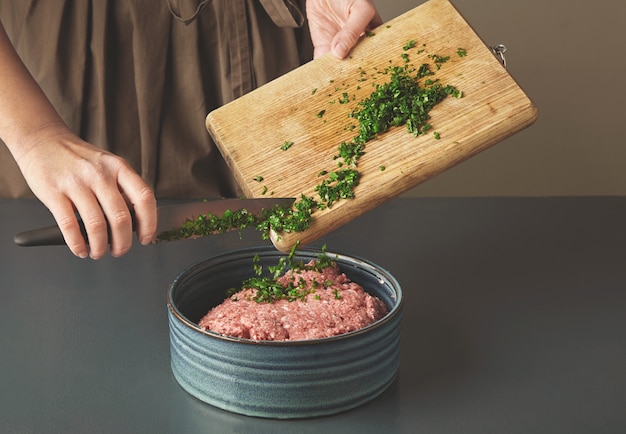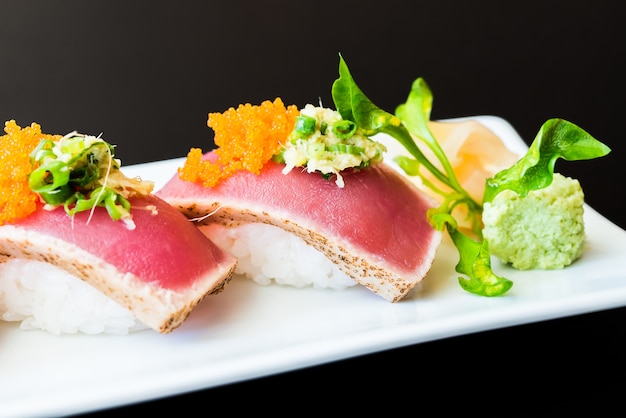You've got some beautiful yellowfin tuna, and you want to whip up something truly delicious? You've come to the right place! This versatile fish can be grilled, baked, seared, even enjoyed raw – the possibilities are endless! I've been a huge fan of yellowfin tuna for years, experimenting with different flavours and cooking techniques, and I'm excited to share my top tips and favourite recipes with you. So, let's dive into the wonderful world of yellowfin tuna cooking!
(Part 1) Choosing the Right Tuna: A Guide to Freshness and Variety

Picking Your Fish: The Quest for Freshness
First things first, you need to pick the right tuna. I always recommend going for fresh, as it simply has the best flavour and texture. When you're at the fishmonger, look for tuna that has a vibrant red colour, firm flesh, and a slightly sweet scent. Give it a good sniff – if it smells fishy or ammonia-like, it's probably not fresh and should be avoided.
Different Cuts, Different Uses: Navigating the Tuna Landscape
There are different cuts of tuna, each with its own ideal cooking method:
Steak: These thick, juicy slices are perfect for grilling or searing. They hold up well to strong flavours and create a beautiful, restaurant-quality presentation.
Loin: Lean and slightly milder, loin is great for baking or pan-frying. It flakes beautifully, making it ideal for dishes like tuna salad or fish tacos.
Belly: The fattiest cut, known for its rich, buttery flavour. It's delicious seared or used in sushi and other raw dishes where its richness shines.
Frozen vs. Fresh: When to Embrace the Frozen Option
Of course, sometimes you might not be able to get your hands on fresh tuna. That's where frozen comes in. Just make sure you pick a good quality frozen tuna that's been flash-frozen to preserve its flavour and texture. You can defrost it in the fridge overnight before using, ensuring it thaws evenly and doesn't lose its delicate flavour.
(Part 2) Preparing Your Tuna: A Step-by-Step Guide

The Art of Skinning and Filleting: Mastering a Crucial Skill
Now, you've got your tuna, and you're ready to get cooking. The first step is often skinning and filleting. I'll be honest, it's not always easy, but with practice, you'll get the hang of it. There are lots of great videos online that can walk you through the process, showing you how to expertly separate the fillets from the skin and bones.
Essential Equipment for Filleting: Your culinary arsenal
You'll need a sharp filleting knife, a sturdy cutting board, and a pair of fish tweezers. The tweezers are handy for removing any pesky pin bones that might be lurking inside the flesh. A good filleting knife will make all the difference, so invest in one that feels comfortable in your hand and is sharp enough to cleanly slice through the tuna.
Don't Overdo It: A Gentle Approach to Seasoning
Once your tuna is filleted, resist the urge to over-season it. Tuna has a delicate flavour, and too much seasoning can mask it. Just a sprinkle of salt and pepper will do the trick, allowing the natural flavour of the tuna to shine through.
(Part 3) The Power of Searing: A Quick and Delicious Technique

A Quick and Easy Method: Bringing Out the Best in Yellowfin
Searing is one of my favourite ways to cook tuna. It's quick, easy, and creates a beautiful crust on the outside while leaving the inside perfectly tender. The result is a delicious contrast of textures and flavours that's sure to impress.
Get Your Pan Hot: The Key to Success
The key to perfect searing is to have a smoking hot pan. Heat a cast iron pan or a heavy-bottomed skillet over high heat until it's smoking hot. This intense heat will create the perfect sear, locking in the juices and developing a crispy crust.
The Magic of Oil: Choosing the Right Lubricant
Add a little oil to the pan, and let it heat up before adding the tuna. I like to use a neutral oil like grapeseed or avocado oil, as they have a high smoke point and won't impart any unwanted flavours.
Don't Overcook It: Timing is Everything
Once the oil is shimmering, carefully add the tuna to the pan. Don't crowd the pan, and let it cook undisturbed for about 2-3 minutes per side for a medium-rare finish. The tuna should be firm to the touch, but still slightly pink in the centre.
(Part 4) Baking Tuna: A Simple and Flavorful Technique
The Perfect Oven Temperature: Finding the Sweet Spot
Baking tuna is a great option for a more hands-off approach. Preheat your oven to 375°F (190°C). This temperature ensures that the tuna cooks evenly without drying out.
Get Creative with Marinades: Adding Depth of Flavour
Before you bake, you can marinade the tuna in a mixture of olive oil, lemon juice, herbs, and spices. I love to use a simple marinade of olive oil, lemon juice, and fresh thyme, but you can experiment with different flavour combinations to create your own signature dish.
Bake to Perfection: Achieving a Deliciously Tender Result
Place the tuna on a baking sheet lined with parchment paper, and bake for 10-12 minutes for a medium-rare finish. You can easily check for doneness by gently pressing on the tuna – it should spring back when cooked.
(Part 5) Grilling Tuna: A Summertime Delight
The Best Grill for the Job: Fueling Your Culinary Fire
Grilling tuna is a classic summertime recipe. Use a gas or charcoal grill for the best results. Both methods will deliver the smoky flavour and char lines that make grilled tuna so irresistible.
Get Your Grill Hot: Setting the Stage for Grilling Success
Heat your grill to medium-high heat. You want to get those nice char lines on the tuna, which will add a beautiful visual element and enhance the flavour.
Grill to Your Preference: Achieving the Perfect Level of Doneness
Once the grill is hot, place the tuna on the grill and cook for about 3-4 minutes per side for a medium-rare finish. You can adjust the cooking time based on your desired level of doneness.
(Part 6) Mastering tuna steak: A Versatile Culinary Star
Tuna Steak: A Culinary Star: A Feast for the Senses
Tuna steak is a versatile ingredient that can be cooked in a variety of ways. It's great for grilling, searing, or baking. The key is to cook it quickly and evenly to prevent it from becoming dry.
Seasoning Secrets: Keeping it Simple and Delicious
Keep the seasoning simple. Salt and pepper are all you really need. You can also add a squeeze of lemon juice or a sprinkle of herbs for a touch of brightness.
Cook Time Matters: Timing Your Culinary Triumph
The cooking time will depend on the thickness of your steak, but aim for 3-4 minutes per side for a medium-rare finish. You can use a meat thermometer to ensure it's cooked to your liking.
(Part 7) The Delight of Tuna Tartare: A Raw culinary adventure
Raw Tuna: A Culinary Adventure: Exploring the Uncooked Side of Tuna
Tuna tartare is a dish that's both delicious and visually appealing. It's made with raw tuna that's chopped or minced and mixed with a variety of ingredients. The result is a refreshing and flavourful dish that's perfect for a light meal or appetizer.
Quality is Crucial: The Foundation of a Great Tartare
For tuna tartare, it's crucial to use fresh, high-quality tuna. If you're not comfortable with raw tuna, you can always lightly sear it before using it in the tartare. This will give it a slightly cooked texture while still retaining its fresh flavour.
A Symphony of Flavours: Creating a Deliciously Balanced Dish
The classic combination for tuna tartare is chopped tuna, capers, shallots, lemon juice, olive oil, and black pepper. But feel free to experiment with different ingredients, such as avocado, red onion, or chopped herbs. These additions will add complexity and depth to your tartare.
(Part 8) The Wonders of Tuna Salad: A Classic comfort food
Tuna Salad: A Classic Comfort Food: A Beloved Culinary Staple
Tuna salad is a simple and versatile dish that can be enjoyed on its own or used as a filling for sandwiches, wraps, or salads. The possibilities are endless with this easy-to-make dish.
A Customizable Creation: A Culinary Canvas for Your Imagination
The beauty of tuna salad is that it's completely customizable. You can add whatever you like, from chopped celery and onion to mayonnaise, mustard, and even a squeeze of lemon juice. Experiment with different flavour combinations to create your own unique version of this classic dish.
Tuna Salad Variations: Exploring the Spectrum of Flavours
Here are a few of my favourite tuna salad variations:
Classic: Tuna, mayonnaise, celery, onion, salt, and pepper. A timeless combination that never disappoints.
Spicy: Tuna, mayonnaise, chopped jalape??os, diced red onion, and a sprinkle of chili powder. For those who enjoy a kick!
Greek: Tuna, mayonnaise, chopped cucumbers, red onion, feta cheese, and a drizzle of olive oil. A Mediterranean twist that's both refreshing and flavorful.
(Part 9) cooking tuna: A Guide to Doneness
Doneness Chart: A Visual Guide to Culinary Perfection
Here's a helpful chart to guide you on the different levels of doneness for tuna:
| Doneness | internal temperature | Description |
|---|---|---|
| Rare | 125°F (52°C) | The tuna will be red in the centre, with a slightly cool texture. |
| Medium-rare | 130°F (54°C) | The tuna will have a slightly pink centre, with a firmer texture. |
| Medium | 140°F (60°C) | The tuna will have a light pink centre, with a cooked texture. |
| Well-done | 150°F (66°C) | The tuna will be cooked through, with a firm texture. |
The Importance of Texture: Finding Your Ideal Level of Doneness
The level of doneness you choose for your tuna will depend on your personal preference. If you like your tuna to be rare, it will have a more delicate texture. If you prefer it well-done, it will have a firmer texture. Experiment with different levels of doneness until you find your perfect match.
(Part 10) Serving Tuna: A Culinary Symphony
Tuna Dishes: A Feast for the Senses: Completing Your Culinary Masterpiece
Once your tuna is cooked, it's time to assemble your meal. There are endless possibilities when it comes to serving tuna.
side dishes: The Perfect Pairing: Harmonious Accompaniments
Tuna goes well with a variety of side dishes, such as:
Salads: Green salads, pasta salads, or potato salads.
Vegetables: grilled vegetables, roasted vegetables, or steamed vegetables.
Grains: Rice, quinoa, or couscous.
Don't Forget the Sauces: Elevating Your Dish with Sauces
A sauce can elevate any tuna dish. Here are some ideas:
Lemon butter sauce: A classic and easy sauce made with melted butter and lemon juice.
Garlic herb sauce: A flavorful sauce made with garlic, herbs, and olive oil.
Soy ginger sauce: A savory sauce made with soy sauce, ginger, and garlic.
(Part 11) Storing and Freezing Tuna: Ensuring Freshness and Longevity
Keeping Tuna Fresh: Maximizing Flavor and Texture
To keep your tuna fresh, store it in the refrigerator for up to 2 days. Wrap it tightly in plastic wrap or aluminum foil.
Freezing for Later: Preserving Your Tuna for Future Delights
You can also freeze tuna for up to 3 months. Wrap it tightly in plastic wrap and then place it in a freezer-safe bag. When freezing, be sure to label the bag with the date so you know how long it's been in the freezer.
FAQs
1. What is the best way to cook yellowfin tuna?
The best way to cook yellowfin tuna depends on your personal preference and the cut of tuna you have. For a quick and easy option, searing is a great choice. For a more hands-off approach, baking is a good option. And for a summertime treat, grilling is always a winner.
2. How do I know when yellowfin tuna is cooked?
The best way to determine if your tuna is cooked is to use a meat thermometer. For medium-rare, aim for an internal temperature of 130°F (54°C). You can also check the texture of the tuna – it should be firm and slightly pink in the centre.
3. What are some good side dishes for yellowfin tuna?
Yellowfin tuna goes well with a variety of side dishes, such as green salads, grilled vegetables, roasted vegetables, steamed vegetables, rice, quinoa, or couscous. Choose side dishes that complement the flavour of the tuna without overpowering it.
4. Can I eat yellowfin tuna raw?
Yes, you can eat yellowfin tuna raw, but it's important to use fresh, high-quality tuna from a reputable source. The most common way to eat raw tuna is in sushi or sashimi. If you're unsure about the freshness of the tuna, it's best to cook it.
5. How do I know if yellowfin tuna is fresh?
Look for tuna that has a bright red colour, firm flesh, and a slightly sweet scent. Avoid tuna that smells fishy or ammonia-like. If you're unsure, ask the fishmonger for their opinion.
There you have it, a comprehensive guide to cooking delicious yellowfin tuna! From choosing the right fish to serving it up with a smile, I hope this has inspired you to get in the kitchen and create some culinary magic. And remember, the most important thing is to enjoy the process and experiment with different flavours and techniques. Happy cooking!
Everyone is watching

Perfect Rice Every Time: The Ultimate Guide to Cooking Rice
Cooking TipsAs a self-proclaimed foodie, I've always been a bit obsessed with rice. It's the foundation of countless cuisi...

Prime Rib Roast Cooking Time Chart: Per Pound Guide
Cooking TipsPrime rib roast. Just the name conjures images of lavish dinners, crackling fires, and hearty laughter. It’s ...

The Ultimate Guide to Cooking Asparagus: Tips, Techniques, and Recipes
Cooking TipsAsparagus. The mere mention of this spring delicacy conjures up images of vibrant green spears, crisp and burs...

Ultimate Guide to Cooking the Perfect Thanksgiving Turkey
Cooking TipsThanksgiving. Just the word conjures up images of overflowing tables laden with delicious food, the scent of r...

How Long to Bake Potatoes in the Oven (Perfect Every Time)
Cooking TipsBaked potatoes are a staple in my kitchen. They're incredibly versatile, delicious, and surprisingly easy to m...
